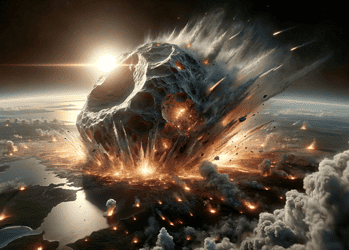Could it be that the asteroid that killed off the dinosaurs 66 million years ago was not the only one to impact the Earth? How unlucky can you get?

Turns out, the dinos could have experienced a one-two punch that they couldn’t recover from. In the journal Science Advances, researchers report finding what appears to be the scar in the eastern Atlantic Ocean of a smaller impact that occurred around the same time.
For a long time, researchers have wondered what could have caused the extinction of the dinosaurs. Now, pretty much all evidence suggests that the big extinction event between the Cretaceous and Paleogene geological periods was caused by an extraterrestrial invasion of the asteroid kind. More specifically, the cosmic catastrophe left the Chicxulub impact crater, 180 kilometers (110 miles) wide, under the current coastline of the Yucatán peninsula in Mexico. The asteroid itself was some 12 kilometers (0.62 miles) wide.
Now, scientists have found that a smaller crater located about 350 kilometers (217 miles) off the coast of Guinea and Guinea Bissau in Africa is roughly the same age as Chicxulub, and provides evidence that the two asteroids were most likely connected in leading to the demise of the dinosaurs.
“Our stratigraphic framework suggests that the crater formed at or near the Cretaceous-Paleogene boundary, approximately the same age as the Chicxulub impact crater,” the authors wrote in their study. “We hypothesize that this formed as part of a closely timed impact cluster or by breakup of a common parent asteroid.”
The Nadir crater, named after a nearby seamount, is about nine kilometers (5.6 miles) across. Seismic data reveal the typical circular structure with a raised rim and central peak despite being buried beneath several hundred meters of sediment.
Using the crater’s position in relation to different layers of rock, the authors calculate that it is 66 million years old, with a margin of error of at least 500,000 years.
A member of the team, Veronica Bray of the Lunar and Planetary Laboratory, Tucson, used computer modeling to propose that a 400-meter-wide asteroid could have formed Nadir Crater, resulting in widespread regional devastation and a global, 900-meter-high (2,953-foot) tsunami.
So, could there be a link to Chicxulub? In the opinion of Nicholson and his associates, it could have been caused by a trio of factors.
One possibility is that a pair of asteroids collided and caused damage. There are confirmed cases of dual impacts, such as the Lockne and Malingen craters in Sweden, which date back 470 million years, and many asteroids are known to be accompanied by small moonlets.
A second is similar situation to how Jupiter’s tidal forces tore apart Comet Shoemaker-Levy 9 before the resulting fragments smashed into that planet’s atmosphere in 1994. It is possible that the original asteroid broke up into one large and several small pieces as a result of tidal forces during an earlier close encounter with Earth.
Last but not least, the team speculates about an impact cluster, similar to the one that occurred during the Ordovician period when an asteroid collision caused a greater-than-average rate of meteorite impacts over a few million years. It’s also interesting to note that Ukraine’s 24-kilometer-wide Boltysh crater, estimated to be 65.4 million years old, may have formed as part of the same impact cluster.
“We do expect a collision of a Nadir-sized asteroid every 700,000 years or so,” the researchers wrote in The Conversation. “For now, however, we cannot definitively state that the Nadir crater was formed by an asteroid impact until we physically recover samples from the crater floor, and identify minerals that can only be formed by extreme shock pressures. To that end, we have recently submitted a proposal to drill the crater through the International Ocean Discovery Program. As with the main impact crater hypothesis, we can only test the little sister and little cousin hypotheses by accurately dating the crater using these samples, as well as by looking for other candidate craters of a similar age.”
Is it possible that something of this can also occur in the future? Although it’s highly improbable, their modeled asteroid is close in size to the Bennu asteroid currently in near-Earth orbit. There is a one-in-1,750 chance of this asteroid colliding with Earth in the next couple of centuries, making it one of the most hazardous objects in the solar system, however, there is still a 99.94% chance it won’t hit our planet. For now, we’ve got bigger problems.






